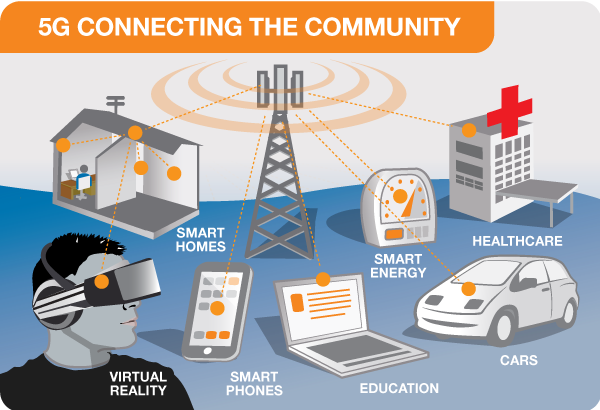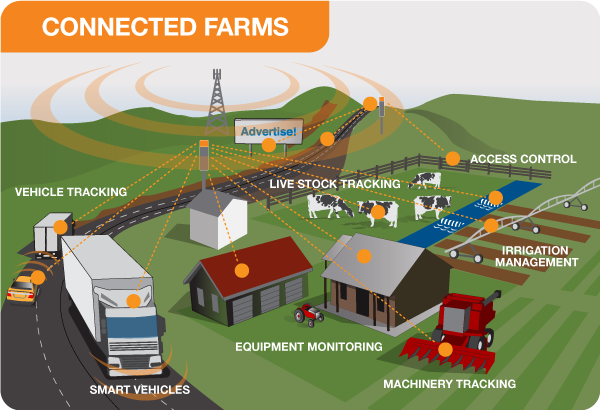Basic Information
5G is abbreviation of 5th Generation Wireless Systems or 5th Generation Mobile Networks, in which the service area covered by providers is divided into a mosaic of small geographical areas called cells. 5G networks will operate in a high-frequency band of the wireless spectrum, between 28 GHz and 60GHz. This range id known as the millimeter wave (mmWave) spectrum. Millimeter have shorter range than microwaves, therefore the cells are limited to smaller size. The waves also have trouble passing through building walls, requiring multiple antennas to cover a cell and multiple bitstreams of data will be transmitted simultaneously. The 6GHz range that LTE calls home will also be used, as the new networks use 4G for initially establishing the connection with the cell, as well as in locations where 5G access is not available.
In addition to greater bandwidth, the new 5G networks will have a dense, distributed network of base stations in the small cell infrastructure. This will allow more processing to happen on the edge, leading to lower latencies Wireless infrastructure today includes many element: macro base stations, metro cells, outdoor and indoor distribution antenna systems (DAS), small cells and more - all working together in a heterogeneous network, or HetNet (see figure below)

Source: Qorvo
A small cell is basically a miniature base station that breaks up a cell site into much smaller pieces, and is a term that encompasses pico cells, micro cells, femtocells and can comprise of infoor or outdorr systems. Purpose of small is to increase the macro cell's edge data capacity, speed and overall network efficiency. Small cells are used in populated urban areas, such as shopping mall - basically anyplace you have a lot of people using data at a given point in time. Today most small cell infrastructure deployments are targeted for outdoor use.

Source: Qorvo
5G will provide increased data capacity, lower latency and longer battery life.
- 5G will not replace 4G. It simply enables a larger diversity of applications that 4G cannot perform. 4G networks such as small cells will continue to advance in parallel with 5G
- 5G NR (nore radio) networks are not expected to be operational until at least 2020, which means 5G mobile devices will not show up until after 5G networks are imcorporated

Source: Qorvo
Advantages of small cells:
- Provide increased data capacity
- Help service providers eliminate expensive rooftop systems and installation or rental costs, which reduces the overall cost
- Help improve the performance of mobile handsets. If your phone is closer to a small cell base station, it transmits at lower power levels, which effectively lowers the power out of the cell phone and substantially increases its battery life.
However, since the signals cannot penetrate walls or buildings, the cell size will have a coverage radius of less than 500 meters. As a result, we need tens of thousands of small cells
There are three major catagories of use case for 5G:
- Massive machine to machine communications: also called the Internet of Things (IoT) that involves connecting billions of devices without human intervention at a scale not seen before. This has the potential to revolutionise modern industrial processes and applications including agriculture, manufacturing and business communications.
- Ultra-reliable low latency communications: mission critical including real-time control of devices, industrial robotics, vehicle to vehicle communications and safety systems, autonomous driving and safer transport networks. Low latency communications also opens up a new world where remote medical care, procedures, and treatment are all possible.
- Enhanced mobile broadband: providing significantly faster data speeds and greater capacity keeping the world connected. New applications will include fixed wireless internet access for homes, outdoor broadcast applications without the need for broadcast vans, and greater connectivity for people on the move.
For communities, 5G will enable the connection of billions of devices for our smart cities, smart schools and smart homes, smart and safer vehicles, enhance health care and education, and provide a safer and more efficient place to live.
For businesses and industry, 5G and IoT will provide a wealth of data allowing them to gain insights into their operations like never before. Businesses will operate and make key decisions driven by data, innovate in agriculture, smart farms and manufacturing, paving the way for cost savings, better customer experience and long term growth.
New and Emerging technologies such as virtual and augmented reality will be accessible by everyone. Virtual reality provides connected experiences that were not possible before. With 5G and VR you will be able to travel to your favourite city, watch a live football match with the feeling of being at the ground, or even be able to inspect real estate and walk through a new home all from the comfort of your couch.

5G will keep us connected in tomorrow’s smart cities, smart homes and smart schools, and enable opportunities that we haven’t even thought of yet. 5G Enhanced Mobile Broadband and IoT will revolutionise agriculture and farming.
